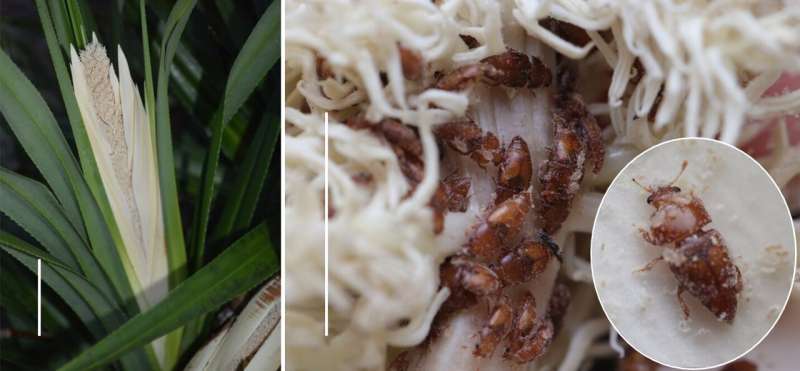This article has been reviewed according to Science X's editorial process and policies. Editors have highlighted the following attributes while ensuring the content's credibility:
fact-checked
peer-reviewed publication
trusted source
proofread
Research finds fragrant screw pines are pollinated by sap beetles rather than by wind

Researchers Toru Miyamoto, Ko Mochizuki, and Atsushi Kawakita of the University of Tokyo have discovered the first species pollinated by sap beetles in the genus Pandanus, a group of palm-like plants native to the tropics and subtropics of Africa and Eurasia.
The discovery overturned the long-held belief that these plants were pollinated by wind. The researchers also found that fragrant screw pines' male and female flowers produced heat at night stably, making them the first such species in the family Pandanaceae. The findings were published in the Botanical Journal of the Linnean Society.
The genus Pandanus, a member of the family Pandanaceae, boasts around 450 species spread around the paleotropical region. The species of this genus have male inflorescences, clusters of flowers on branches, that are pendent and nectarless, which has made scientists assume they are pollinated by wind.
However, some of their other properties, such as floral scent and the fact that female inflorescences mature while bracts (specialized leaves) are still present, suggest otherwise. To clarify the pollination mechanisms, the researchers decided to investigate a species native to subtropical Japan called Pandanus odorifer, commonly known as fragrant screw pines.
The researchers took a multistep approach. They conducted fieldwork during three flowering seasons between 2020 and 2022 on five islands of the Ryukyu Archipelago. They observed visitors at various flowering stages.
Although many small insects visited the flowers, Amystrops sap beetles were the most numerous. So, the team examined the amount of pollen attached to the beetles' bodies to ascertain whether the amount was enough for pollination.
The team also needed to verify whether the beetles were visiting the flowers when they were receptive to pollination. Measuring the receptivity of stigmas, a necessary element for pollination, overlapped with the highest number of beetles found visiting the flowers.
These findings together suggest that Amystrops sap beetles are pollinators of fragrant screw pines. However, the team did not stop there. There had been reports of genus Pandanus in the past that claimed their inflorescences were warm. However, thermogenesis had not been formally investigated before.
"We were very surprised," Miyamoto recalls, "when we found that the floral organs of the P. odorifer actually generated heat. Although it was relatively easy to predict that beetles would be found in the inflorescences, we did not expect to discover floral thermogenesis, both in male and female reproductive organs."
Although Pandanus species are one of the iconic species in the paleotropical region, surprisingly little is known about them. So, in addition to the current findings, many more surprising facts must be out there, waiting to be discovered. Thus, Miyamoto lays out the next steps for further research.
"Pollination research in the family Pandanaceae is a hot topic, and there are high hopes for developments in the future. As such, we would like to elucidate the pollination ecology of the family Pandanaceae in regions where its species are diverse, particularly in Madagascar and South-East Asia."
More information: Toru Miyamoto et al, Pollination of thermogenic inflorescence of Pandanus odorifer by a specialist Amystrops sap beetle that reproduces on the male inflorescence, Botanical Journal of the Linnean Society (2024). DOI: 10.1093/botlinnean/boae012
Journal information: Botanical Journal of the Linnean Society
Provided by University of Tokyo




















